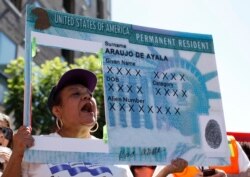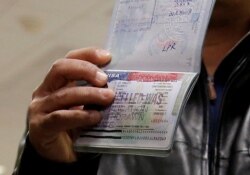A new executive order from the Trump administration restricts legal immigration to the United States for 60 days beginning Friday. Before signing the order late Wednesday, President Donald Trump cited the need to protect American workers and preserve U.S. health care resources during the COVID-19 pandemic.
Who is affected?
The executive order suspends Lawful Permanent Resident visas, commonly referred to as green cards, for most family members of U.S. citizens and permanent residents who currently live outside the United States and do not have a valid visa or travel document.
The proclamation also suspends green card applications for thousands of people coming to the country through the diversity program or lottery system. Fifty-thousand green cards are available annually to people from countries with historically low rates of immigration to the United States.
What is a green card?
For more than 50 years, the United States has issued green cards to immigrants who are allowed to live permanently in the country. For many, securing a green card is the last step before filing for American citizenship.
According to the U.S. Citizenship and Immigration Service, green cards are most commonly granted to family members of U.S. citizens and legal residents, as well as refugees and asylum seekers admitted to the United States and certain categories of workers.
In Fiscal Year 2019, U.S. Citizenship and Immigration Services (USCIS) granted lawful permanent residence to nearly 577,000 people. Together with U.S. State Department issuance of immigrant visas abroad, the total number of people who obtain permanent residency is about 1.1 million each year.
Who is exempted under the order?
According to the White House, the executive order does not apply to those who already have "an immigrant visa that is valid on the effective date of this proclamation."
Additionally, the order does not block people coming to the U.S. on temporary visas for work or travel. The order does not cover non-immigrant visa holders such as those working in the agricultural field.
The ban also does not apply to health care or medical research professionals, including workers with H1B visas - a category that allows more than 85,000 highly skilled foreigners to come to the U.S. to work for at least 3 years.
According to the order, those who came to the country under the refugee resettlement program or applied for asylum status are also exempted, as are spouses and children of U.S. citizens or permanent residents.
Other exemptions include military families, immigrant investors, and those deemed important for “national interest.”
Is this week’s executive order the only barrier to U.S.-bound immigration?
No. Even before the order was signed, many U.S. embassies had halted visa processing due to COVID-19, impacting those wishing to come to the United States on immigrant as well as nonimmigrant visas.
Additionally, refugee admissions to the United States have been suspended since March 19.
The administration has advised that migrants detained at the U.S.-Mexico border will continue to be turned away for at least another month.
Meanwhile, an agreement was recently reached with Canada and Mexico to extend border restrictions on non-essential travel until at least mid-May. In addition, travel bans from certain countries remain in effect as well as continuing COVID-19 travel restrictions.
What is the impact?
Attorneys and advocates tell VOA the executive order’s impact is hard to predict, given that immigrant arrivals to the United States already have slowed to a trickle.
Boundless Immigration, a Seattle-based firm that helps people navigate America’s immigration process, estimates that roughly one-third of green card applications could be affected by Wednesday’s immigration order so long as it is in effect.
Boundless Immigration co-founder Doug Rand told VOA that Trump’s order is unusual but not necessarily incompatible with U.S. law.
“There's a part of the country’s Immigration and Nationality Act from decades and decades ago that has never been used this aggressively,” Rand said. “But it does give the president broad discretion to ban people from other countries if the president deems it in the national interest. That was the legal justification for the [Trump administration’s 2017] Muslim ban [on travelers from several majority-Muslim nations].”
What about H1B visas for workers in the technology industry?
The executive order does not apply to workers on nonimmigrant visas. But it states that U.S officials will reevaluate nonimmigrant programs “within 30 days of the effective date of this proclamation” and could recommend “other measures to stimulate the United States economy [during the COVID-19 crisis].”
Rosanna Berardi, an immigration lawyer in Buffalo, New York, foresees negative impacts for a broad range of American companies if the executive order is expanded.
“Some of America's largest corporations that we all know and love - like Amazon, Google, Microsoft, Facebook - are very reliant on this H1B [work visa] category,” Berardi said. “It's not that they don't want to hire U.S. workers, they do. It's faster, simpler, easier, cheaper [to hire American workers], but there aren't enough qualified Americans to do those types of jobs, mostly in the tech sector.”
Who welcomed the new policy?
The Trump administration says the executive order is vital to its efforts to revive the economy devastated by the coronavirus pandemic.
Numbers USA, a group advocating restrictive immigration policies, welcomed the order in a statement, saying, “The pandemic adds urgency and a justification for executive action to temporarily halt most immigration and guest worker programs during this current jobs collapse.”
Earlier this week, Trump tweeted that restricting immigration was needed “in light of the attack from the Invisible Enemy [coronavirus], as well as the need to protect the jobs of our GREAT American Citizens.”







